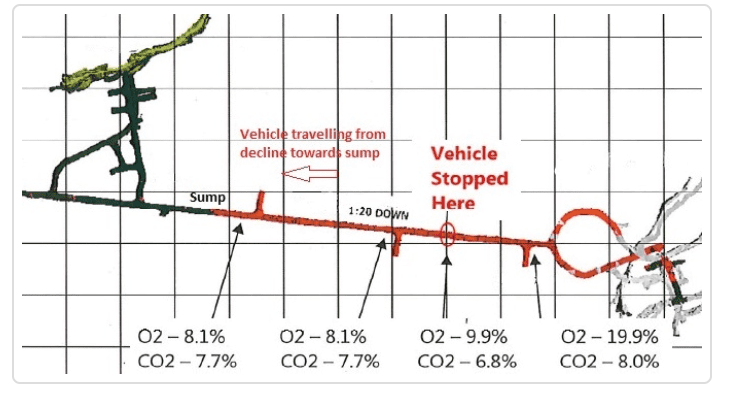The Queensland Department of Natural Resources, Mines & Energy has issued an alert to Queensland Mines after a worker suffered breathing difficulty when he entered old underground workings while seeking to establish a ventilation circuit.
What happened?
An underground mine heading was being progressively de-watered to enable re-entry to old workings and to establish a ventilation circuit. A pump fitter entered the unventilated heading in a light vehicle to check a sump pump when the vehicle’s engine stopped, (see the 50m square grid underground mine plan below).
While the fitter was investigating why the engine had stopped, he experienced “difficulty breathing and identified his heart was beating rapidly”. He called emergency over the radio, donned his self-rescuer and left the area on foot.
The Mine Rescue team, wearing breathing apparatus, investigated the scene and found low oxygen (O2 < 10%) and high carbon dioxide (CO2 > 6.8%) levels. Legislation requires that O2 is not less than 18% by volume. The current exposure standard (Time Weighted Average) for CO2, for all industrial applications except coal mines, is 5000 ppm (0.5%).The pump fitter donning his oxygen-generating self-rescuer prevented this incident from escalating.
How did it happen?
The retreating water level in the sump exposed old workings, including a nearby raise which may have held a pocket of CO2, and/or a chemical reaction occurred in the sump area, resulting in CO2 displacing O2 in the atmosphere.
The lack of ventilation also meant the area was subjected to a build-up of vehicle exhaust fumes.
Comments
- A decision was made to re-enter old workings for remnant mining and to access a new ore block. No risk assessment/technical note was completed prior to accessing the old workings, of which the lower levels were flooded.
- Neither the management team, technical services team nor workers identified the hazard of the unventilated sump area. The site’s procedure had identified unventilated headings as a hazard. Personnel, including supervisors; technical staff and workers had accessed the area without a gas monitor.
- A vent survey identified the area as ‘foggy’. However this, and other areas of inadequate ventilation, were not barricaded to prevent/warn personnel from accessing them.
- The light vehicle stopped due to the oxygen deficient atmosphere. In other incidents, vehicles have experienced poor engine power and black exhaust from incomplete combustion.
- CO2 is:- Water-soluble, but pressure differences will release it, e.g. static head from a diamond drill hole into old workings/open pit above. It can be freed from carbonate rocks by dissolution in water and acids.
- denser than air, so there can be a layering effect, with more CO2/less O2 nearer the floor. If the pump fitter had dropped to the ground, thinking the noxious gas was CO, he would have been exposed to even higher levels of CO2 and lower levels of O2.
Recommendations
Work can only occur in areas which have a sufficient quality, volume and velocity of air to ensure a healthy atmosphere, unless a risk assessment has been completed and appropriate controls put in place. Confined space entry procedures should be considered when entering unventilated headings.
All mines should complete an audit of all unventilated headings to ensure they are:
- Barricaded/secured to prevent inadvertent access
- Signposted as to the nature of the hazard
- Accurately depicted on plans and other relevant documentation.
The Safety and Health Management System should require that:
- Active mine workings are routinely inspected to ensure they have a healthy atmosphere.
- Underground mines must have a competent ventilation officer to establish and implement effective ventilation standards.
- Ventilation surveys must be completed to identify areas of insufficient ventilation, and ensure all personnel are aware of these a hazardous areas. Consideration should be given to a CO2 audit of the mine, particularly where water storage occurs.
- Any change to a ventilation control device should be assessed and modelled to determine its impact on all areas of the mine. Changes should be documented and communicated.
- Installation of ventilation should be as close as reasonably practicable to where personnel are working.
- All unventilated headings must be barricaded and signed to warn personnel of the hazard. Any removal of ventilation from an area should trigger it to be barricaded and signed.
- Workers must be trained in mine ventilation standards and the requirements for gas monitoring of work areas, particular in areas of water storage and old workings. Workers entering non-ventilated headings should be trained in confined space procedures.
- A risk assessment/technical note must be completed prior to work commencing to access old workings, particularly if they have been flooded.
You can follow this link to the original Alert
Read more Mining Safety News














Add Comment